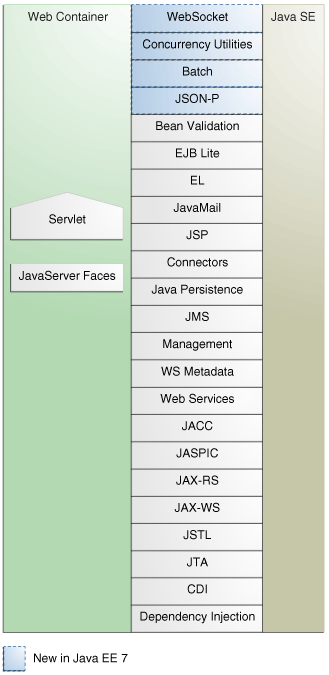原文:http://docs.oracle.com/javaee/7/tutorial/doc/overview007.htm
翻譯:石卓林 shizhuolin@hotmail.com
注意:此章是1.8章前移而來,不知為什么oracle刪除原1.7開發角色章節
Figure 1⑹ shows the relationships among the Java EE containers.
Figure 1⑹ Java EE Containers

Description of "Figure 1⑹ Java EE Containers"
Figure 1⑺ shows the availability of the Java EE 7 APIs in the web container.
Figure 1⑺ Java EE APIs in the Web Container

Description of "Figure 1⑺ Java EE APIs in the Web Container"
Figure 1⑻ shows the availability of the Java EE 7 APIs in the EJB container.
Figure 1⑻ Java EE APIs in the EJB Container

Description of "Figure 1⑻ Java EE APIs in the EJB Container"
Figure 1⑼ shows the availability of the Java EE 7 APIs in the application client container.
Figure 1⑼ Java EE APIs in the Application Client Container

Description of "Figure 1⑼ Java EE APIs in the Application Client Container"
The following sections give a brief summary of the technologies required by the Java EE platform and the APIs used in Java EE applications.
圖 1⑹ 顯示了Java EE容器之間的關系.
圖 1⑹ Java EE 容器

"圖 1⑹ Java EE 容器"簡介
圖 1⑺ 顯示了在web容器中可使用的Java EE 7 APIs.
圖 1⑺ Web容器中的 Java EE APIs

"圖 1⑺ Web容器中的 Java EE APIs"簡介
圖 1⑻ 顯示了在EJB容器中可用的Java EE 7 APIs.
圖 1⑻ EJB容器中的Java EE APIs

"圖 1⑻ EJB容器中的Java EE APIs"簡介
圖 1⑼顯示了在利用客戶端容器中可用的Java EE 7 APIs.
圖 1⑼ 利用客戶端容器中的Java EE 7 APIs

"圖 1⑼ 利用客戶端容器中的Java EE 7 APIs"簡介
以下章節扼要敘述了Java EE平臺所需技術和Java EE利用中使用的APIs.
An Enterprise JavaBeans (EJB) component, or enterprise bean, is a body of code that has fields and methods to implement modules of business logic. You can think of an enterprise bean as a building block that can be used alone or with other enterprise beans to execute business logic on the Java EE server.
Enterprise beans are either session beans or message-driven beans.
In the Java EE 7 platform, new enterprise bean features include the following:
The Java EE 7 platform requires Enterprise JavaBeans 3.2 and Interceptors 1.2. The Interceptors specification is part of the EJB specification.
1個 企業JavaBeans (EJB)組件或企業bean是1段代碼,其有業務邏輯實行模塊的字段和方法.你可以認為1個企業bean是1個積木構件,它能被單獨使用或作為其他Java EE服務器上的企業beans履行業務邏輯.
企業bean是會話bean或消息驅動bean:
在Java EE 7平臺中,企業bean包括以下新功能:
Java EE 7平臺要求企業JavaBeans 3.2和Interceptors(攔截器) 1.2. 該攔截器規范是EJB規范的1部份.
Java Servlet technology lets you define HTTP-specific servlet classes. A servlet class extends the capabilities of servers that host applications accessed by way of a request-response programming model. Although servlets can respond to any type of request, they are commonly used to extend the applications hosted by web servers.
In the Java EE 7 platform, new Java Servlet technology features include the following:
The Java EE 7 platform requires Servlet 3.1.
Java Servlet技術允許你定義基于HTTP規范的servlet類. servlet類作為服務器的功能延伸, 允許通過要求-響應編程模型的方式訪問主機. Although 雖然servlet可以對任何類型的要求作出響應, 但他們通常被用于擴大web服務器托管的利用程序.
在Java EE 7平臺中, Java Servlet技術包括以下新功能:
Java EE 7平臺要求Servlet 3.1.
JavaServer Faces technology is a user interface framework for building web applications. The main components of JavaServer Faces technology are as follows:
The following features support the GUI components:
All this functionality is available using standard Java APIs and XML-based configuration files.
In the Java EE 7 platform, new features of JavaServer Faces technology include the following:
The Java EE 7 platform requires JavaServer Faces 2.2 and Expression Language 3.0.
JavaServer Faces 技術是用于構建web利用的UI框架. 以下是JavaServer Faces技術的主要組成部份:
GUI組件支持以下功能:
所有功能可使用標準的Java API或基于XML的配置文件.
在Java EE 7平臺中, JavaServer Faces技術包括以下新功能:
Java EE 7平臺要求JavaServer Faces 2.2和Expression Language 3.0.
JavaServer Pages (JSP) technology lets you put snippets of servlet code directly into a text-based document. A JSP page is a text-based document that contains two types of text:
For information about JSP technology, see the The Java EE 5 Tutorial at http://docs.oracle.com/javaee/5/tutorial/doc/.
The Java EE 7 platform requires JavaServer Pages 2.3 for compatibility with earlier releases but recommends the use of Facelets as the display technology in new applications.
JavaServer Pages (JSP) 技術讓你可以在基于文本的文檔中嵌入servlet代碼片斷. JSP頁面是基于文本的文檔,其包括兩種文本類型:
關于JSP技術的信息可以查看Java EE 5教程 at http://docs.oracle.com/javaee/5/tutorial/doc/.
Java EE 7 平臺為兼容初期版本要求JavaServer Pages 2.3,但推薦在新利用中使用Facelets顯示技術.
The JavaServer Pages Standard Tag Library (JSTL) encapsulates core functionality common to many JSP applications. Instead of mixing tags from numerous vendors in your JSP applications, you use a single, standard set of tags. This standardization allows you to deploy your applications on any JSP container that supports JSTL and makes it more likely that the implementation of the tags is optimized.
JSTL has iterator and conditional tags for handling flow control, tags for manipulating XML documents, internationalization tags, tags for accessing databases using SQL, and tags for commonly used functions.
The Java EE 7 platform requires JSTL 1.2.
JavaServer頁面標準標簽庫(JSTL)封裝多數JSP利用中常見的核心功能. 這樣就不需要在你的JSP利用中混合使用來自不同廠商的各種標簽. 它是單1的,標準的,標簽集合. 這類標準化允許你部署利用到支持JSTL的任意JSP容器時感覺更容易,更容易對標簽實現進行優化.
JSTL有用于處理控制流的迭代和條件標簽, 用于操作XML文檔的標簽,國際化標簽,通過SQL訪問數據庫的標簽和經常使用功能標簽.
Java EE 7平臺要求JSTL 1.2.
The Java Persistence API (JPA) is a Java standards
